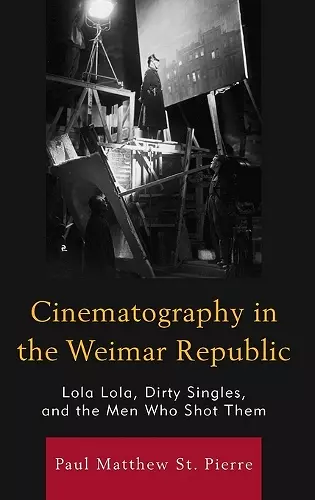Cinematography in the Weimar Republic
Lola Lola, Dirty Singles, and the Men Who Shot Them
Format:Hardback
Publisher:Fairleigh Dickinson University Press
Published:15th Aug '16
Currently unavailable, and unfortunately no date known when it will be back
This hardback is available in another edition too:
- Paperback£45.00(9781611479461)

In film history, director-cinematographer collaborations were on a labor spectrum, with the model of the contracted camera operator in the silent era and that of the cinematographer in the sound era. But in Weimar era German filmmaking, 1919-33, a short period of intense artistic activity and political and economic instability, these models existed side by side due to the emergence of camera operators as independent visual artists and collaborators with directors. Berlin in the 1920s was the chief site of the interdisciplinary avant-garde of the Modernist movement in the visual, literary, architectural, design, typographical, sartorial, and performance arts in Europe. The Weimar Revolution that arose in the aftermath of the November 1918 Armistice and that established the Weimar Republic informed and agitated all of the art movements, such as Expressionism, Dada, the Bauhaus, Minimalism, Objectivism, Verism, and Neue Sachlichkeit (“New Objectivity”). Among the avant-garde forms of these new stylistically and culturally negotiated arts, the cinema was foremost and since its inception had been a radical experimental practice in new visual technologies that proved instrumental in changing how human beings perceived movement, structure, perspective, light exposure, temporal duration, continuity, spatial orientation, human postural, facial, vocal, and gestural displays, and their own spectatorship, as well as conventions of storytelling like narrative, setting, theme, character, and structure. Whereas most of the arts mobilized into schools, movements, institutions, and other structures, cinema, a collaborative art, tended to organize around its ensembles of practitioners. Historically, the silent film era, 1895-1927, is associated with auteurs, the precursors of François Truffaut and other filmmakers in the 1960s: actuality filmmakers and pioneers like R. W. Paul and Fred and Joe Evans in England, Auguste and Luis Lumière and Georges Méliès in France, and Charles Chaplin and Buster Keaton in America, who, by managing all the compositional, executional, and editorial facets of film production—scripting, directing, acting, photographing, set, costume, and lighting design, editing, and marketing—imposed their personal vision or authorship on the film. The dichotomy of the auteur and the production ensemble established a production hierarchy in most filmmaking. In formative German silent film, however, this hierarchy was less rank or class driven, because collaborative partnerships took precedence over single authorship. Whereas in silent film production in most countries the terms filmmaker and director...
Offering both historical and aesthetic analysis of film in the culture of the Weimar Republic, St. Pierre (English, Simon Fraser Univ.) attempts to redefine how cinematic production during the period between 1918 and 1933 should be categorized and understood. Specifically, in considering the filmmaker, or Filmemacher, he highlights the impact of the collaborations between cinematographers and directors on film production and film aesthetics. For St. Pierre, both types of artists can be considered filmmakers. The author constructs a history of Weimar cinema using the work of cinematographers Theodor Sparkuhl, Karl Freund, Carl Hoffmann, Fritz Arno Wagner, Günther Rittau, Guido Seeber, and Rudolph Maté, among others. Devoting a chapter to each, St. Pierre looks at the work of these artists across the oeuvres of Weimar cinema’s major directors: Ernst Lubitsch, Fritz Lang, F. W. Murnau, et al. By this means, St. Pierre is able not only to disrupt some standard assumptions of film historiography but also to point toward less-known lines of continuity in Weimar film history.... Summing Up: Recommended. Researchers and faculty. * CHOICE *
ISBN: 9781611479447
Dimensions: 233mm x 161mm x 26mm
Weight: 585g
286 pages